Small Strain Shear Modulus of the Ljubljana Marsh Soil Measured with Resonant Column and Bender Elements under Isotropic and Anisotropic Stress Conditions
Abstract
:1. Introduction
Assessment of Soil Stiffness at Small Strains
2. Testing Equipment and Methods
2.1. Bender Elements
2.2. Resonant Column Test
3. Test Arrangement and Procedure
4. Materials
5. Test Results and Discussion
5.1. Influence of Sample Size
5.2. G Measurements
5.3. G/G0 Curves
6. Conclusions
- , measured with BE, is slightly higher than , measured with RC. The reason for this is that RC was not able to measure at , which is also in agreement with Schaeffer et al. [52]. When the measurements were extended according to the modified Hardin–Drnevich model, both (BE) and (model) were within 10% of each other. In addition, the integration of the BE into the RC device facilitates the quality control of the measurements and thus increases the confidence in the measurement results.
- For the BE test, no significant influence of specimen height on the was found in this study. It was also found that for the RC test, shortening the specimen height to 1.4 times the diameter had no significant effect on the measured and the curve.
- Corrections of due to for these soft soils are not absolutely necessary. The range of in which developed in our experiments is similar to the results of Hsu and Vucetic [61].
- It was found that was dependent on and . Trends similar to those of the empirical models were observed, with the exception that was lower than the value reported by other authors. However, large differences were also found between the empirical models. Apparently, there is no universally valid empirical model for the prediction of the curve, as reported by Sobol et al. [19]. It is, therefore, recommended to perform measurements on local soils, especially in cases where the validity of the empirical relationships has not yet been confirmed.
- and at the same were comparable for isotropic and anisotropic stress conditions, indicating that there is no significant influence of the anisotropic stress conditions on the curve for this cohesive soil.
- It can be seen that both isotropic and anisotropic tests led to an approximately equal curve if the test was performed at a stress state close to the field value of . Testing at significantly higher or lower led to different . To obtain reliable shear modulus values at small strains, the tests should, therefore, be performed close to the field conditions.
Author Contributions
Funding
Institutional Review Board Statement
Informed Consent Statement
Data Availability Statement
Acknowledgments
Conflicts of Interest
References
- Gaberc, A. Napovedano in opazovano posedanje Južne obvoznice. In Proceedings of the 1st Šuklje Symposium, Ljubljana, Slovenia, 12 October 2000; Gaberc, A.M., Majes, B., Eds.; Slovenian Geotechnical Society: Ljubljana, Slovenia, 2000; pp. 121–128. [Google Scholar]
- Mencej, Z. Prodni Zasipi pod Jezerskimi Sedimenti Ljubljanskega Barja. Geologija 1980, 31–32, 517–533. [Google Scholar]
- Jardine, R.J.; Potts, D.M.; Fourie, A.B.; Burland, J.B. Studies of the Influence of Non-Linear Stress–Strain Characteristics in Soil–Structure Interaction. Géotechnique 1986, 36, 377–396. [Google Scholar] [CrossRef]
- Burland, J.B. Ninth Laurits Bjerrum Memorial Lecture: “Small Is Beautiful”—The Stiffness of Soils at Small Strains. Can. Geotech. J. 1989, 26, 499–516. [Google Scholar] [CrossRef]
- Schanz, T.; Vermeer, P.A.; Bonnier, P.G. The hardening soil model: Formulation and verification. In Beyond 2000 in Computational Geotechnics; Routledge: London, UK, 2019; pp. 281–296. ISBN 1315138204. [Google Scholar]
- Benz, T. Small-Strain Stiffness of Soils and Its Numerical Consequences. Ph.D. Thesis, University of Stuttgart, Stuttgart, Germany, 2007. [Google Scholar]
- Obrzud, R.F. On the Use of the Hardening Soil Small Strain Model in Geotechnical Practice. Numer. Geotech. Struct. 2010, 16, 1–17. [Google Scholar]
- Wong, J.K.H.; Wong, S.Y.; Wong, K.Y. Extended Model of Shear Modulus Reduction for Cohesive Soils. Acta Geotech. 2022, 17, 2347–2363. [Google Scholar] [CrossRef]
- Kishida, T. Comparison and Correction of Modulus Reduction Models for Clays and Silts. J. Geotech. Geoenviron. Eng. 2017, 143, 04016110. [Google Scholar] [CrossRef]
- Ferreira, C.; Viana da Fonseca, A.; Santos, J.A. Comparison of Simultaneous Bender Elements and Resonant Column Tests on Porto Residual Soil. In Soil Stress-Strain Behavior: Measurement, Modeling and Analysis, Proceedings of the Geotechnical Symposium in Rome, Italy, 16–17 March 2006; Ling, H.I., Callisto, L., Leshchinsky, D., Koseki, J., Eds.; Solid Mechanics and Its Applications; Springer: Dordrecht, The Netherlands, 2007; Volume 146, pp. 523–535. ISBN 978-1-4020-6145-5. [Google Scholar]
- Camacho-Tauta, J.; Santos, J.A.; Fonseca, A.V. Two Bender Receivers Frequency Domain Analysis in Resonant Column Tests. In Advances in Soil Dynamics and Foundation Engineering, Geotechnical Special Publication 240; Society of Civil Engineers: New York, NY, USA, 2014; pp. 72–82. [Google Scholar]
- Camacho-Tauta, J.; Cascante, G.; Santos, J.A. Measurements of Shear Wave Velocity by Resonant-Column Test, Bender Element Test and Miniature Accelerometers. In Proceedings of the Pan-Am CGS Geotechnical Conference; Canadian Geotechnical Society: Richmond, BC, Canada, 2001; Volume 949, pp. 1–9. [Google Scholar]
- Pereira, C.; Correia, A.G.; Ferreira, C.; Santos, J.; Santos, J. Measurement of Shear Modulus Using Bender Elements and Resonant-Column. In Fundamentals to Applications in Geotechnics, Proceedings of the 15th Pan-Am Conference on Soil Mechanics and Geotechnical Engineering, 15–18 November 2015; IOS Press: Buenos Aires, Argentina, 2015; pp. 120–129. [Google Scholar] [CrossRef]
- Sas, W.; Gabryś, K.; Szymański, A. Comparison of resonant column and Bender elements tests on selected cohesive soil from Warsaw. Electron. J. Pol. Agric. Univ. EJPAU 2014, 17, 7. Available online: http://www.ejpau.media.pl/volume17/issue3/art-07.html (accessed on 23 July 2014).
- Clayton, C.R.I. Stiffness at Small Strain: Research and Practice. Géotechnique 2011, 61, 5–37. [Google Scholar] [CrossRef]
- Hardin, B.O.; Black, W.L. Vibration Modulus of Normally Consolidated Clay. J. Soil Mech. Found. Div. 1968, 94, 353–369. [Google Scholar] [CrossRef]
- Vucetic, M.; Dobry, R. Effect of Soil Plasticity on Cyclic Response. J. Geotech. Eng. 1991, 117, 89–107. [Google Scholar] [CrossRef]
- Presti, L. Estimate of Elastic Shear Modulus in Holocene Soil Deposits. Soils Found. 1998, 38, 263–265. [Google Scholar]
- Soból, E.; Gabryś, K.; Zabłocka, K.; Šadzevičius, R.; Skominas, R.; Sas, W. Laboratory Studies of Small Strain Stiffness and Modulus Degradation of Warsaw Mineral Cohesive Soils. Minerals 2020, 10, 1127. [Google Scholar] [CrossRef]
- Sun, J.; Golesorkhi, R.; See, H. Dynamic Moduli and Damping Ratio for Cohesive Soils; Report No. UCB/EERC-88/15; University of California Berkeley-Earthquake Engineering Research Center: Berkeley, CA, USA, 1988; 42p. [Google Scholar]
- Hardin, B.O.; Drnevich, V.P. Shear Modulus and Damping in Soils: Design Equations and Curves. J. Soil Mech. Found. Div. 1972, 98, 667–692. [Google Scholar] [CrossRef]
- Darendeli, M. Development of a New Family of Normalized Modulus Reduction and Material Damping Curves. Ph.D. Thesis, University of Texas, Austin, TX, USA, 2001. [Google Scholar]
- Santos, J.A.; Correia, A.G. Reference threshold shear strain of soil, its application to obtain a unique strain-dependent shear modulus curve for soil. In Proceedings of the 15th International Conference on Soil Mechanics and Geotechnical Engineering, Istanbul, Turkey, 27–31 August 2001; pp. 267–270. [Google Scholar]
- Ishibashi, I.; Zhang, X. Unified Dynamic Shear Moduli and Damping Ratios of Sand and Clay. Soils Found. 1993, 33, 182–191. [Google Scholar] [CrossRef]
- Lanzo, G.; Vucetic, M.; Doroudian, M. Reduction of Shear Modulus at Small Strains in Simple Shear. J. Geotech. Geoenviron. Eng. 1997, 123, 1035–1042. [Google Scholar] [CrossRef]
- Kokusho, T.; Yoshida, Y.; Esashi, Y. Dynamic Properties of Soft Clay for Wide Strain Range. Soils Found. 1982, 22, 1–18. [Google Scholar] [CrossRef] [PubMed]
- Stokoe, K.H.; Darendeli, M.B.; Andrus, R.D.; Brown, L.T. Dynamic soil properties: Laboratory, field and correlation studies. In Earthquake Geotechnical Engineering; A A Balkema: Rotterdam/Brookfield, The Netherlands, 1999; pp. 811–845. [Google Scholar]
- Vardanega, P.J.; Bolton, M.D. Stiffness of Clays and Silts: Normalizing Shear Modulus and Shear Strain. J. Geotech. Geoenviron. Eng. 2013, 139, 1575–1589. [Google Scholar] [CrossRef]
- Electric Power Research Institute—EPRI. Guidelines for Determining Design Basis Ground Motions; Report EPRI TR-102293; EPRI: Palo Alto, CA, USA, 1993. [Google Scholar]
- Zhang, J.; Andrus, R.D.; Juang, C.H. Normalized Shear Modulus and Material Damping Ratio Relationships. J. Geotech. Geoenviron. Eng. 2005, 131, 453–464. [Google Scholar] [CrossRef]
- Ciancimino, A.; Lanzo, G.; Alleanza, G.A.; Amoroso, S.; Bardotti, R.; Biondi, G.; Cascone, E.; Castelli, F.; Di Giulio, A.; d’Onofrio, A.; et al. Dynamic Characterization of Fine-Grained Soils in Central Italy by Laboratory Testing. Bull. Earthq. Eng. 2020, 18, 5503–5531. [Google Scholar] [CrossRef]
- Stokoe, K.H.; Hwang, S.K.; Darendeli, M.B.; Lee, N.J. Correlation Study of Nonlinear Dynamic Soils Properties; Westinghouse Savannah River Co.: Aiken, SC, USA, 1995. [Google Scholar]
- Payan, M.; Chenari, R.J. Small Strain Shear Modulus of Anisotropically Loaded Sands. Soil Dyn. Earthq. Eng. 2019, 125, 105726. [Google Scholar] [CrossRef]
- Jafarian, Y.; Javdanian, H. Small-Strain Dynamic Properties of Siliceous-Carbonate Sand under Stress Anisotropy. Soil Dyn. Earthq. Eng. 2020, 131, 106045. [Google Scholar] [CrossRef]
- Goudarzy, M.; Magnanimo, V.; König, D.; Schanz, T. Anisotropic Stress State and Small Strain Stiffness in Granular Materials: RC Experiments and DEM Simulations. Meccanica 2020, 55, 1869–1883. [Google Scholar] [CrossRef]
- Pennington, D.S.; Nash, D.F.T.; Lings, M.L. Anisotropy of G0 Shear Stiffness in Gault Clay. Géotechnique 1997, 47, 391–398. [Google Scholar] [CrossRef]
- Hao, G.L.; Lok, T.M.H. Study of Shear Wave Velocity of Macao Marine Clay under Anisotropic Stress Condition. In Proceedings of the 14 World Conference on Earthquake Engineering, Beijing, China, 12–17 October 2008. [Google Scholar]
- Shirley, D.J.; Hampton, L.D. Shear-wave Measurements in Laboratory Sediments. J. Acoust. Soc. Am. 1978, 63, 607–613. [Google Scholar] [CrossRef]
- Dyvik, R.; Olsen, T.S. Gmax measured in oedometer and DSS tests using bender elements. In Proceedings of the 12th International Conference on Soil Mechanics and Foundation Engineering, ICSMFE 1989, Rio de Janeiro, Brazil, 13–18 August 1989; Publications Committee of XII ICSMFE, Ed.; Taylor & Francis: Milton Park, UK, 1989; Volume 1, pp. 39–42. [Google Scholar]
- Jovičić, V.; Coop, M.P. The Measurement of Stiffness Anisotropy in Clays with Bender Element Tests in the Triaxial Apparatus. Geotech. Test. J. 1998, 21, 3–10. [Google Scholar] [CrossRef]
- Wang, Y.; Benahmed, N.; Cui, Y.-J.; Tang, A.M. A Novel Method for Determining the Small-Strain Shear Modulus of Soil Using the Bender Elements Technique. Can. Geotech. J. 2017, 54, 280–289. [Google Scholar] [CrossRef]
- Ingale, R.; Patel, A.; Mandal, A. Performance Analysis of Piezoceramic Elements in Soil: A Review. Sens. Actuators Phys. 2017, 262, 46–63. [Google Scholar] [CrossRef]
- Gao, Y.; Zheng, X.; Wang, H.; Luo, W. Effect of Wave Attenuation on Shear Wave Velocity Determination Using Bender Element Tests. Sensors 2022, 22, 1263. [Google Scholar] [CrossRef] [PubMed]
- Yamashita, S.; Kawaguchi, T.; Nakata, Y.; Mikami, T.; Fujiwara, T.; Shibuya, S. Interpretation of International Parallel Test on the Measurement of Gmax Using Bender Elements. Soils Found. 2009, 49, 631–650. [Google Scholar] [CrossRef]
- Sas, W.; Gabryś, K.; Soból, E.; Szymański, A. Dynamic Characterization of Cohesive Material Based on Wave Velocity Measurements. Appl. Sci. 2016, 6, 49. [Google Scholar] [CrossRef]
- Stokoe II, K.H.; Lodde, P.F. Dynamic Response of San Francisco Bay Mud. In From Volume I of Earthquake Engineering and Soil Dynamics, Proceedings of the ASCE Geotechnical Engineering Division Specialty Conference, Pasadena, CA, USA, 19–21 June 1978; Sponsored by Geotechnical Engineering Division of ASCE in Cooperation with; American Society of Civil Engineers: New York, NY, USA, 1978; Volume 2, pp. 940–959. [Google Scholar]
- Lai, C.G. Simultaneous Inversion of Rayleigh Phase Velocity and Attenuation for Near-Surface Site Characterization; Georgia Institute of Technology: Atlanta, GA, USA, 1998. [Google Scholar]
- Ishimoto, M.; Iida, K. Determination of Elastic Constants of Soils by Means of Vibration Methods; Bulletin of the Earthquake Research Institute: Tokyo, Japan, 1937; Volume 15, 67p. [Google Scholar]
- Hall, J.R.; Richart, F.E. Dissipation of Elastic Wave Energy in Granular Soils. J. Soil Mech. Found. Div. 1963, 89, 27–56. [Google Scholar] [CrossRef]
- Hardin, B.O.; Music, J. Apparatus for Vibration of Soil Specimens During Triaxial Test. In Apparatus for Vibration of Soil Specimens During the Triaxial Test; ASTM International: West Conshohocken, PA, USA, 1965; Volume 436, pp. 55–74. [Google Scholar]
- Drnevich, V.P. Effects of Strain History on the Dynamic Properties of Sand. Ph.D. Thesis, University of Michigan, Ann Arbor, MI, USA, 1967. [Google Scholar]
- Schaeffer, K.; Bearce, R.; Wang, J. Dynamic Modulus and Damping Ratio Measurements from Free-Free Resonance and Fixed-Free Resonant Column Procedures. J. Geotech. Geoenviron. Eng. 2013, 139, 2145–2155. [Google Scholar] [CrossRef]
- Gabrys, K.; Sobol, E.; Markowska-Lech, K.; Szymański, A. Shear Modulus of Compacted Sandy Clay from Various Laboratory Methods. IOP Conf. Ser. Mater. Sci. Eng. 2019, 471, 042022. [Google Scholar] [CrossRef]
- Wichtmann, T.; Sonntag, T.; Triantafyllidis, T. Über das Erinnerungsvermögen von Sand unter zyklischer Belastung. Bautechnik 2001, 78, 852–865. [Google Scholar] [CrossRef]
- Kumar, J.; Clayton, C.R. Effect of Sample Torsional Stiffness on Resonant Column Test Results. Can. Geotech. J. 2007, 44, 221–230. [Google Scholar] [CrossRef]
- ISO 17892-1:2014; Geotechnical Investigation and Testing—Laboratory Testing of Soil—Part 1: Determination of Water Content. European Commission for Standardization: Brussels, Belgium, 2014.
- ISO 17892-2:2014; Geotechnical Investigation and Testing—Laboratory Testing of Soil—Part 2: Determination of Bulk Density. European Commission for Standardization: Brussels, Belgium, 2014.
- ISO 114688-2:2017; Geotechnical Investigation and Testing—Identification and Classification of Soil—Part 2: Principles for a Classification. ISO copyright office: Geneva, Switzerland, 2017.
- ISO 17892-12:2018; Geotechnical Investigation and Testing—Laboratory Testing of Soil—Part 12: Determination of Liquid and Plastic Limits. European Commission for Standardization: Brussels, Belgium, 2014.
- Kramer, S. Performance-based design methodologies for geotechnical earthquake engineering. Bull. Earthq. Eng. 2013, 12, 1049–1070. [Google Scholar] [CrossRef]
- Hsu, C.-C.; Vucetic, M. Threshold Shear Strain for Cyclic Pore-Water Pressure in Cohesive Soils. J. Geotech. Geoenviron. Eng. 2006, 132, 1325–1335. [Google Scholar] [CrossRef]
- Brinkgreve, R.; Engin, E.; Engin, H.K. Validation of Empirical Formulas to Derive Model Parameters for Sands. In Numerical Methods in Geotechnical Engineering; Taylor & Francis Group: London, UK, 2010; ISBN 978-0-415-59239-0. [Google Scholar]
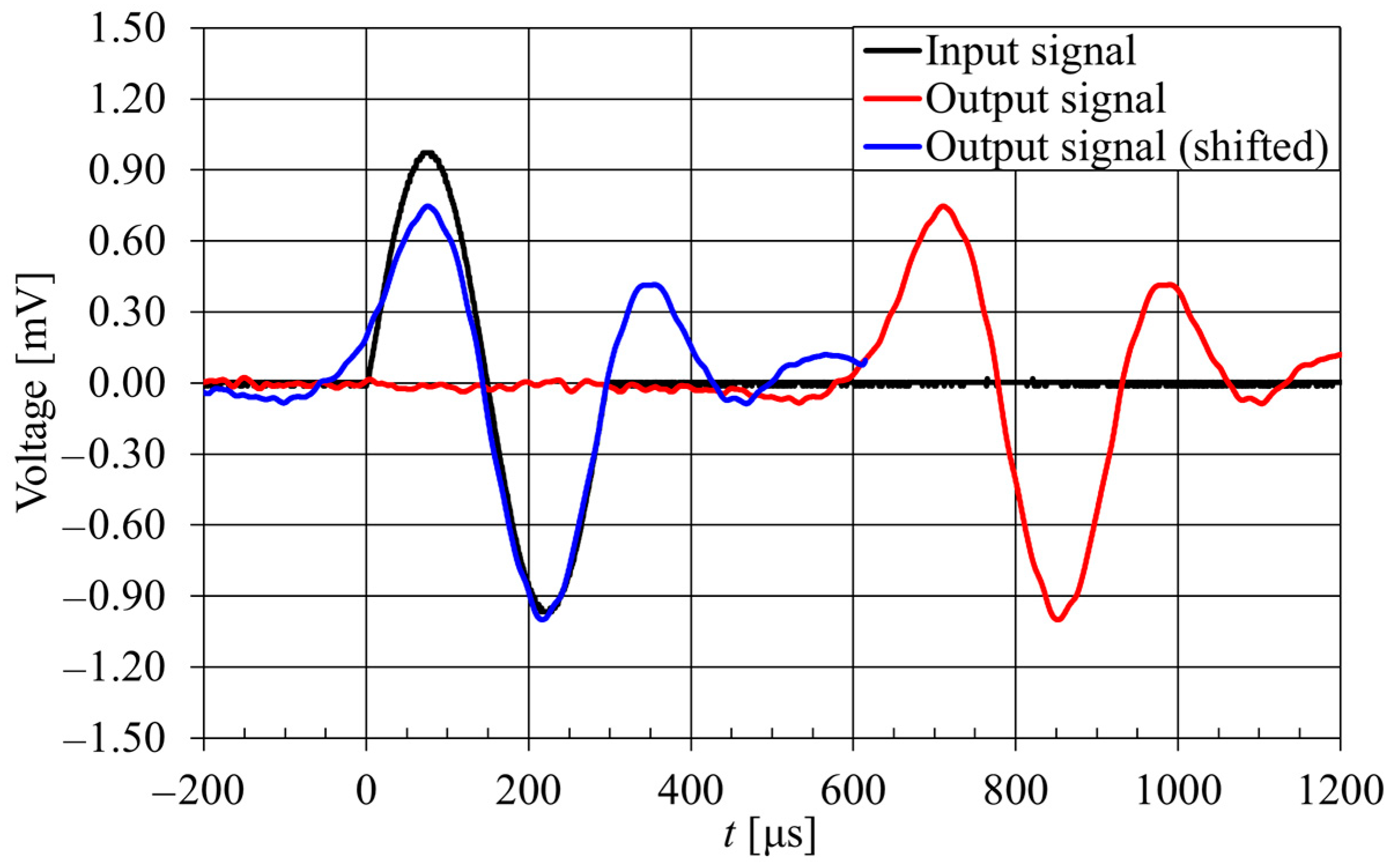
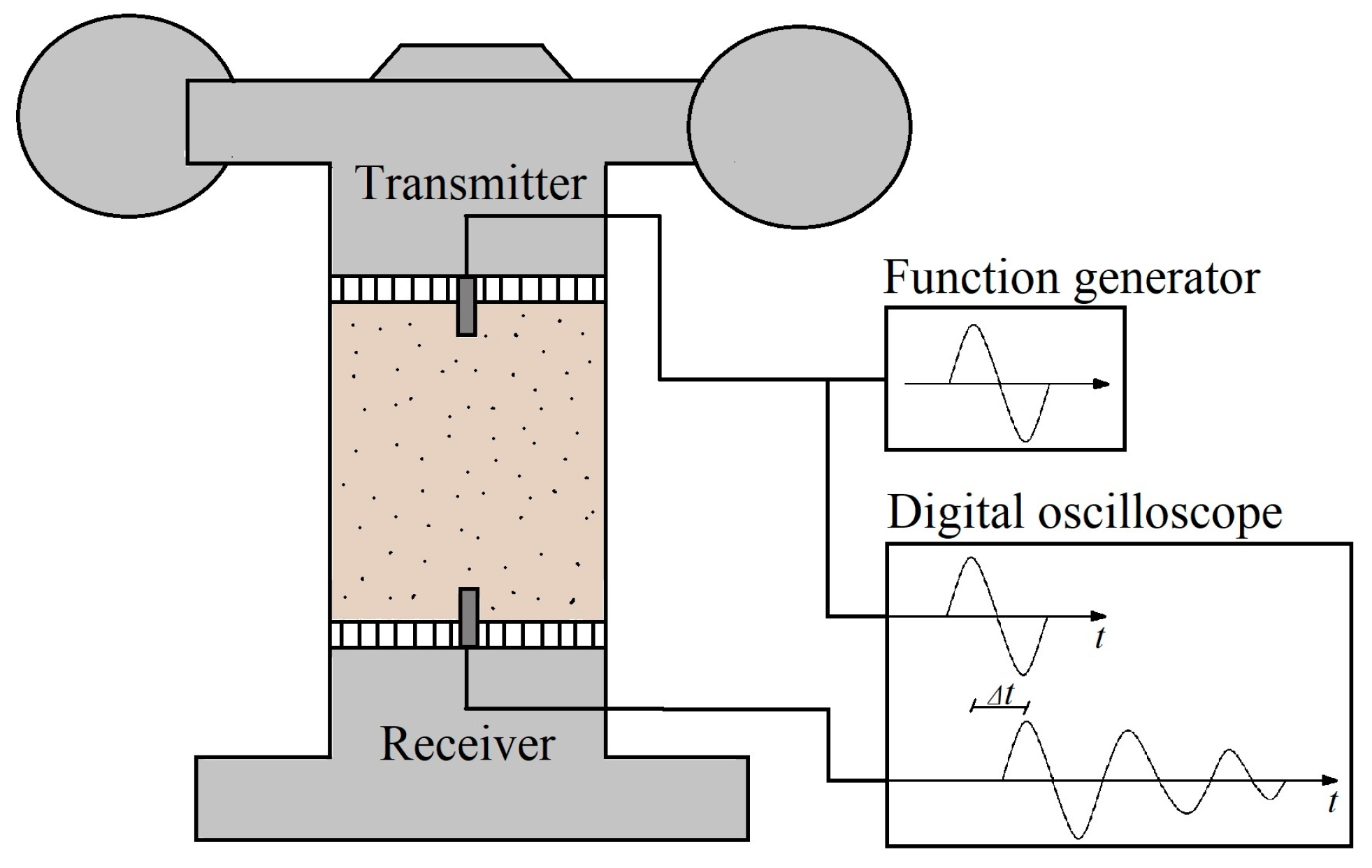
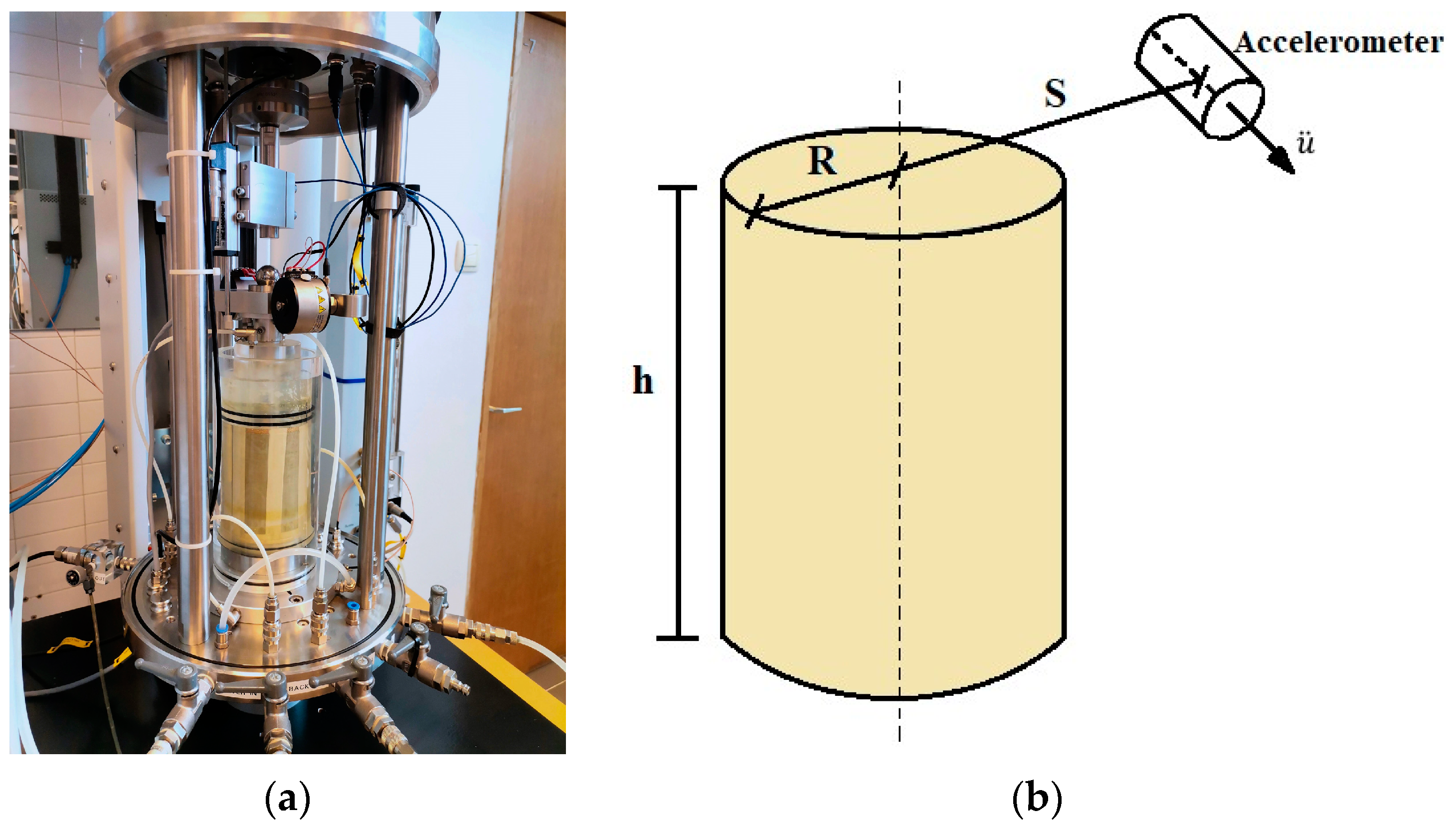

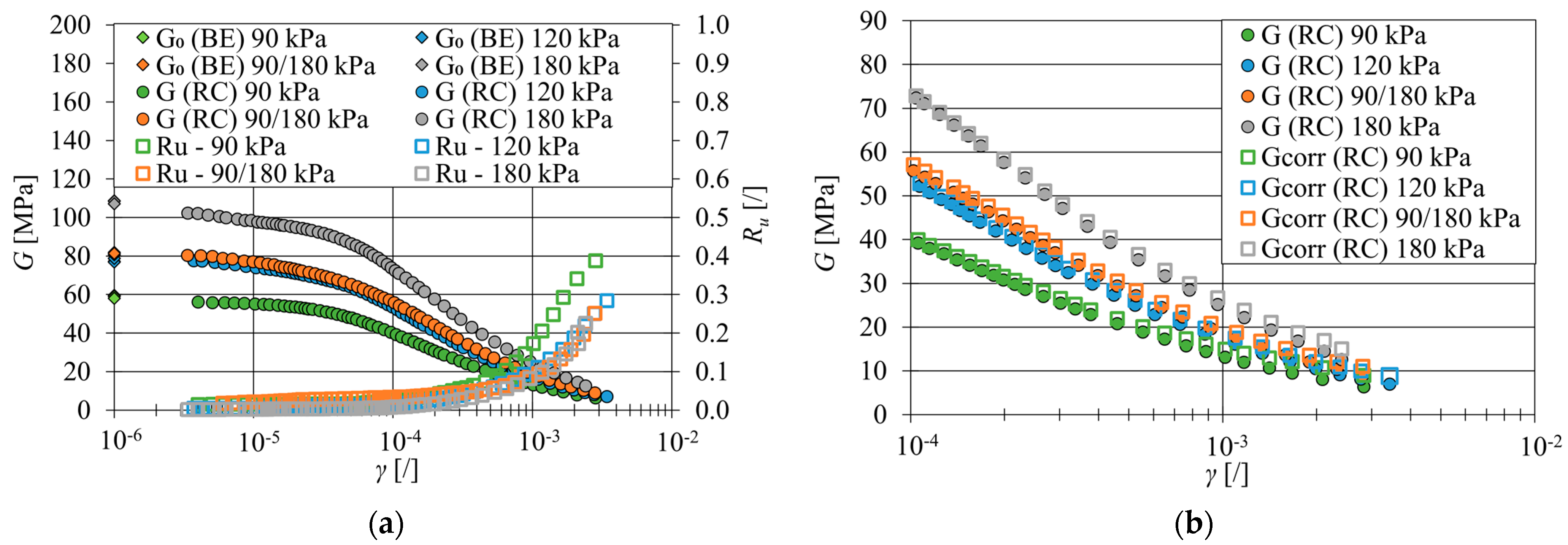

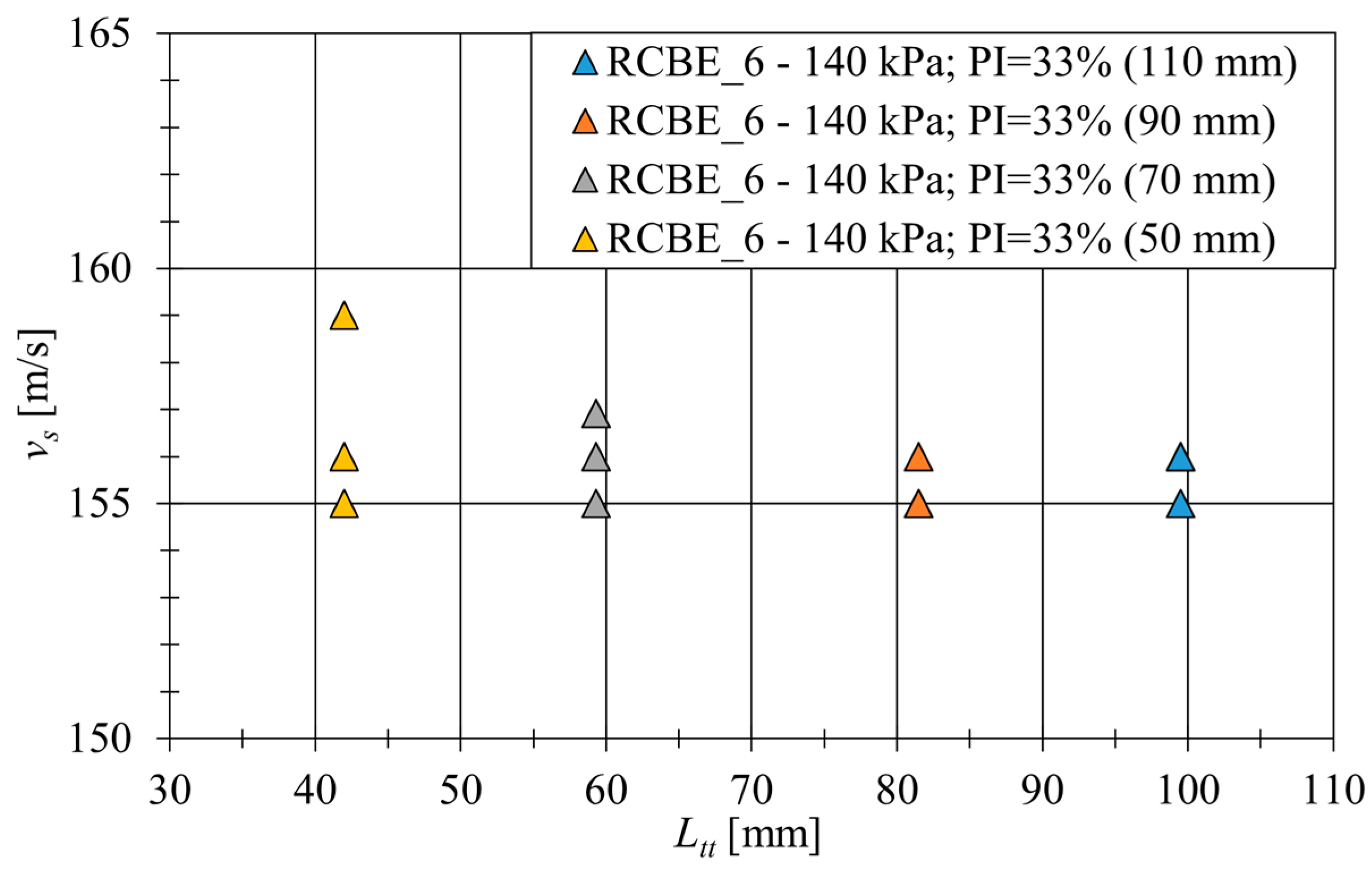

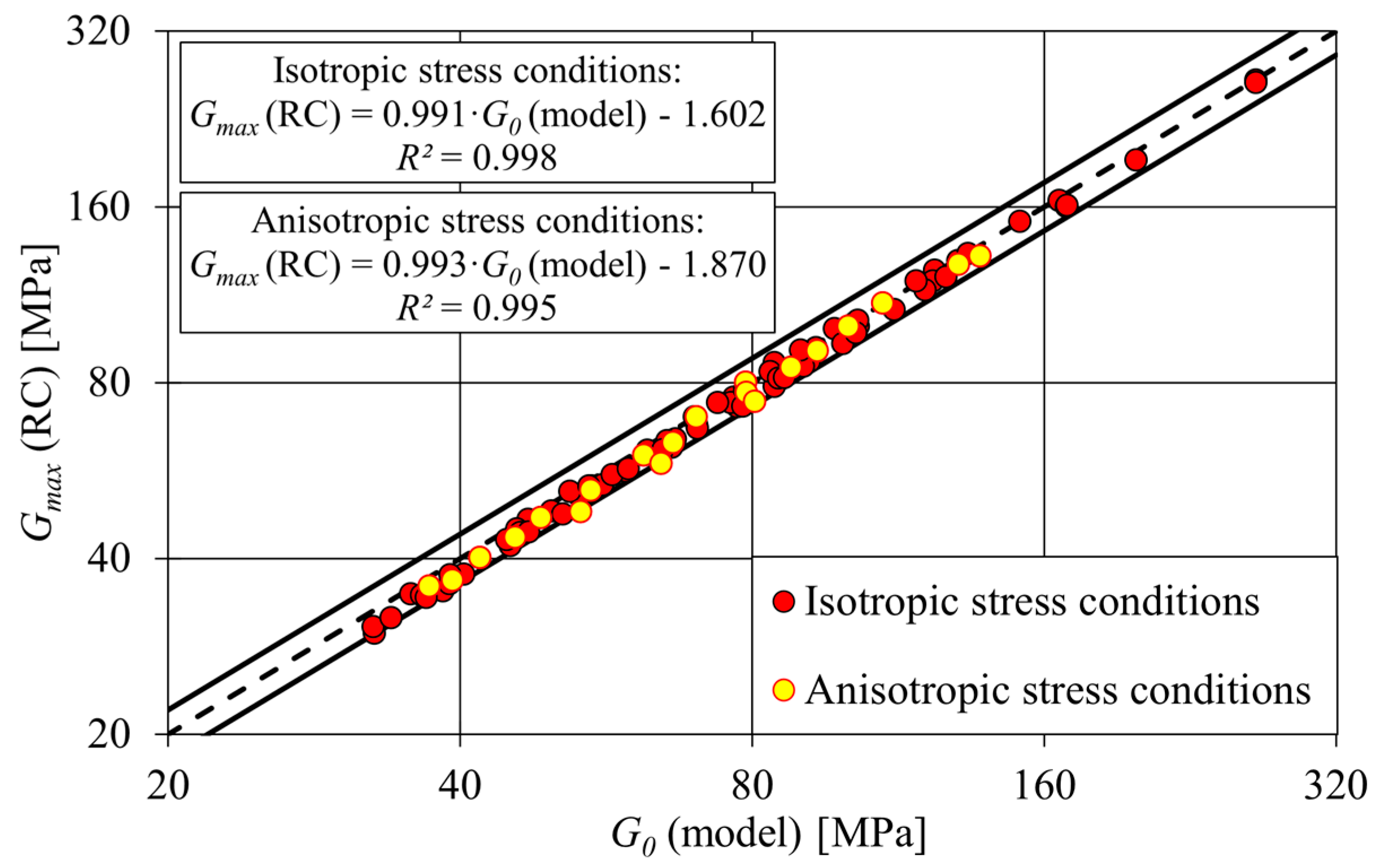
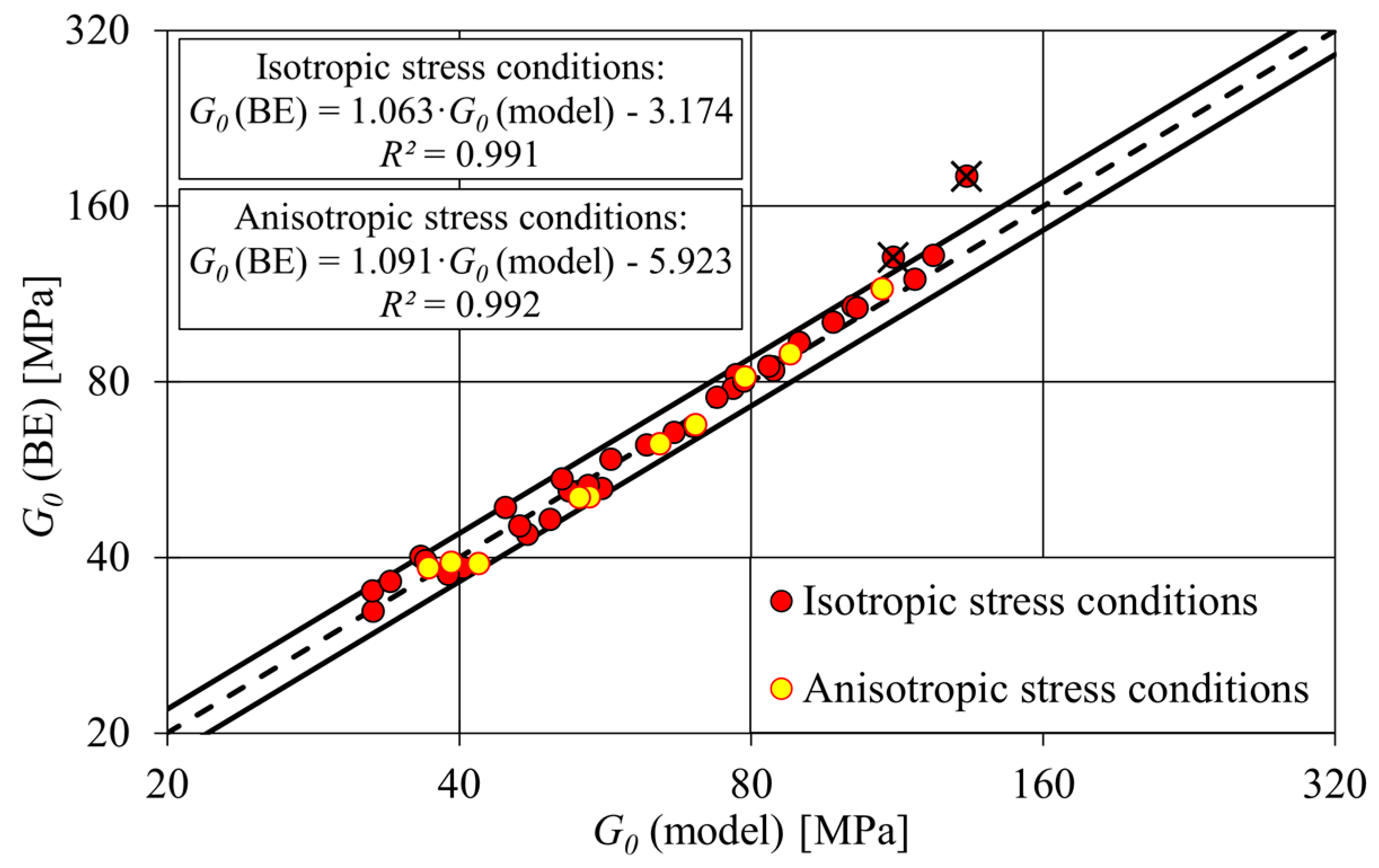

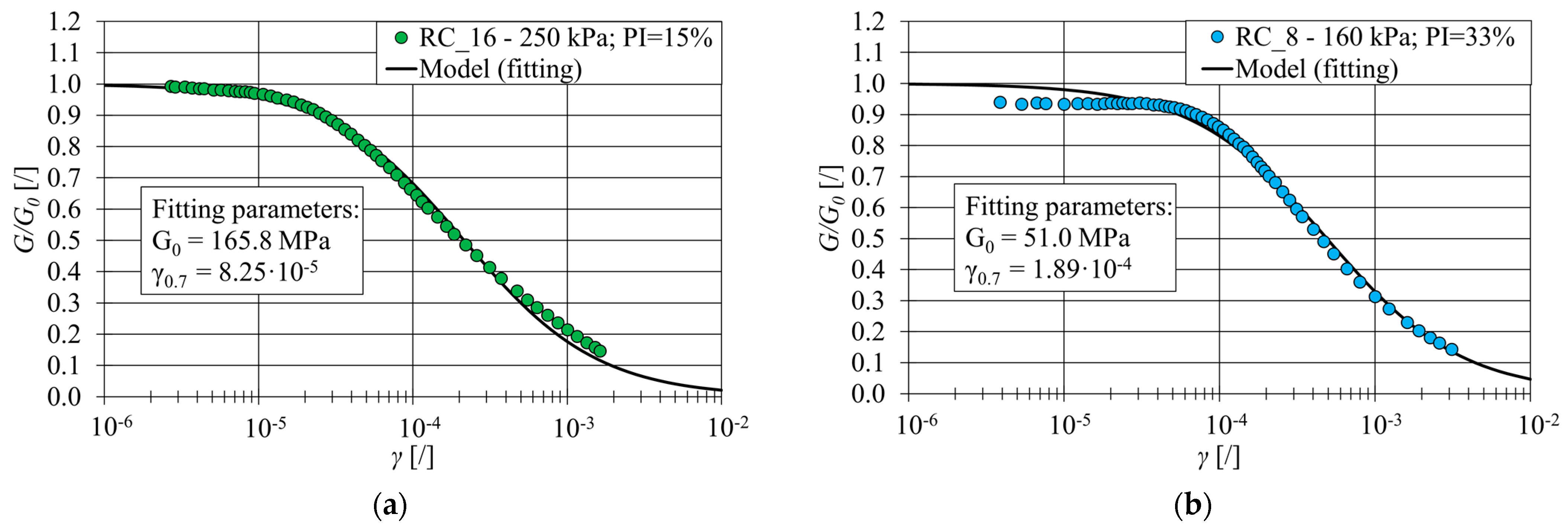
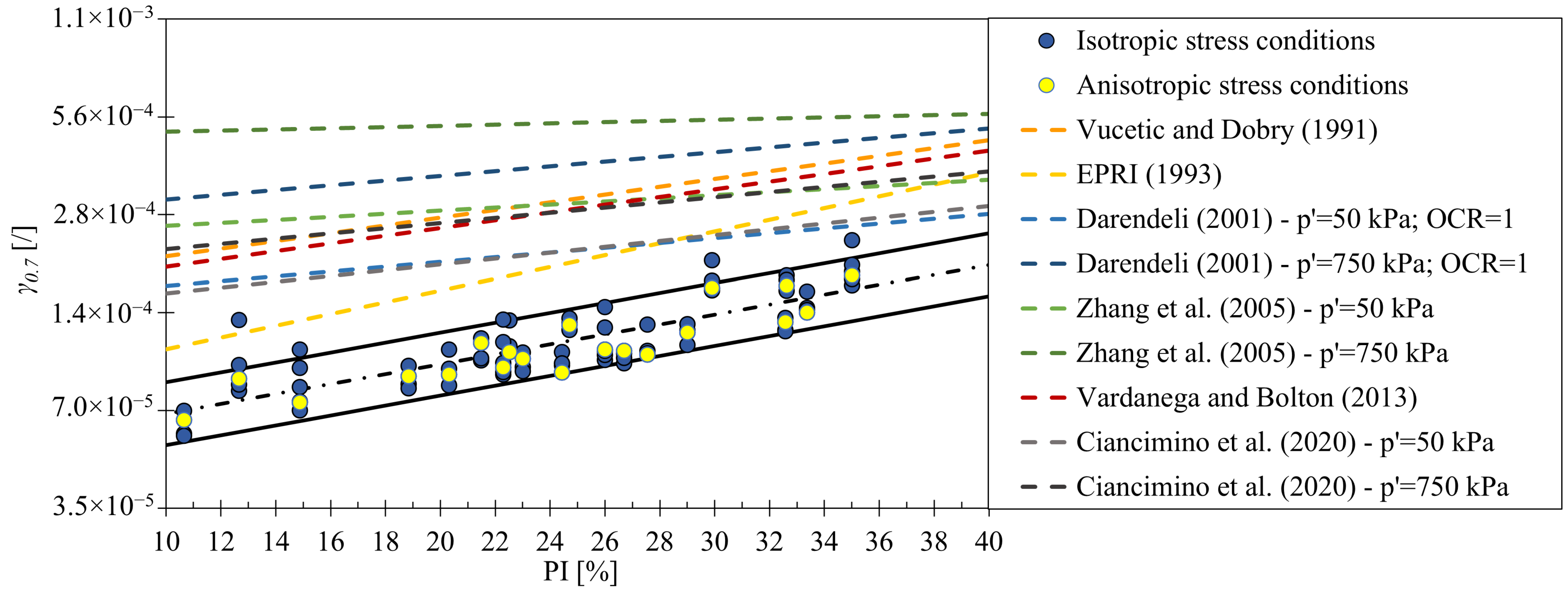
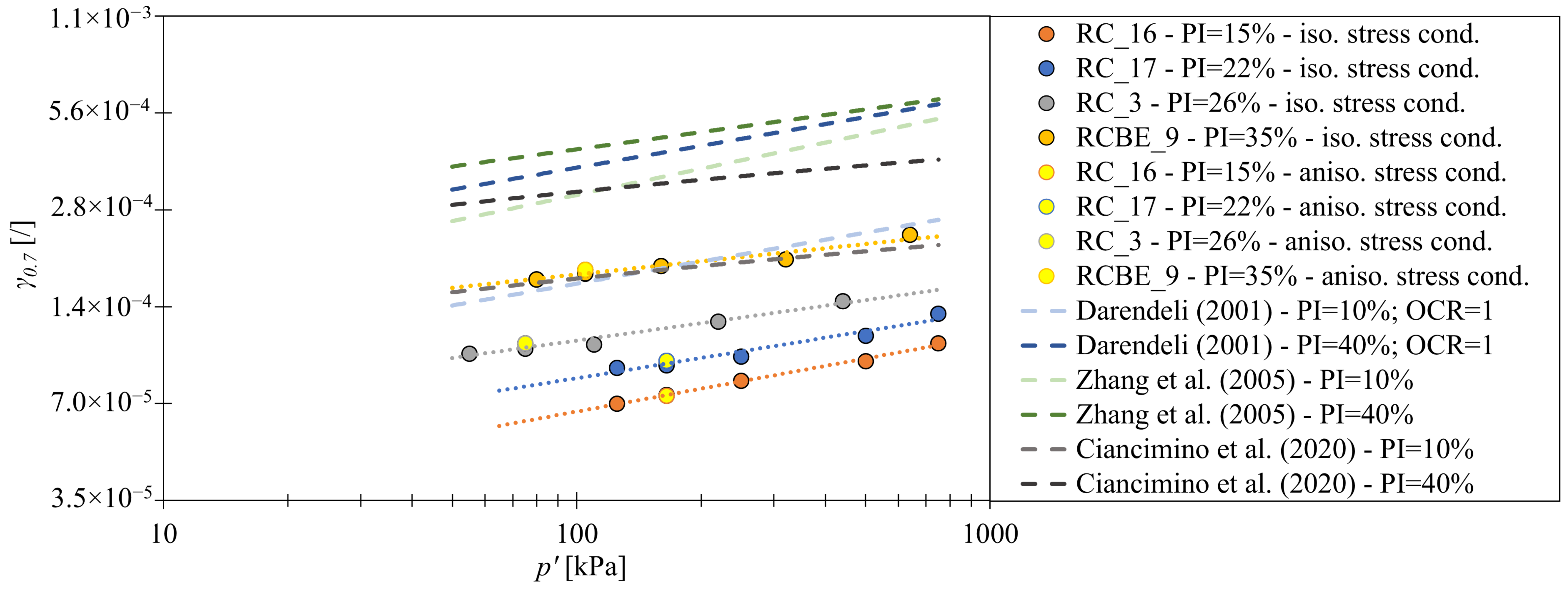
| Reference | ||
|---|---|---|
| Presentation | Parameters | |
| Vucetic and Dobry (1991) [17] | graphically | |
| EPRI (1993) [29] | graphically | |
| Darendeli (2001) [22] | equation | |
| Zhang et al. (2005) [30] | equation | |
| Vardanega and Bolton (2013) [28] | equation | |
| Ciancimino et al. (2020) [31] | equation | |
| Specimen | Soil Type (USCS) [58] | Fines | Testing Conditions | ||||
|---|---|---|---|---|---|---|---|
| [/] | [%] | [%] | [%] | [%] | [kPa] | ||
| RCBE_1 | ClM | 0.835 | 21.1 | 43.6 | 23 | 97 | 50, 65, 50/100, 100 |
| RC_2 | ClM | 0.644 | 16.6 | 35.4 | 19 | 72 | 55, 75, 55/110, 110 |
| RC_3 | ClM | 0.827 | 20.1 | 46.0 | 26 | 95 | 55, 75, 55/110, 110, 220, 440 |
| RCBE_4 | SiH | 0.784 | 33.0 | 60.6 | 28 | 98 | 60, 80, 60/120, 120 |
| RCBE_5 | ClM | 0.848 | 23.0 | 49.7 | 27 | 99 | 65, 85, 65/130, 130 |
| RCBE_6 | ClH | 0.772 | 24.0 | 56.6 | 33 | 97 | 70, 95, 70/140, 140 |
| RCBE_7 | ClL | 0.718 | 20.5 | 33.2 | 13 | 80 | 75, 95, 75/150, 150 |
| RC_8 | ClH | 1.107 | 24.0 | 57.4 | 33 | 98 | 80, 105, 80/160, 160 |
| RCBE_9 | ClH | 0.905 | 23.7 | 55.3 | 35 | 97 | 80, 105, 80/160, 160, 320, 640 |
| RCBE_10 | ClM | 0.828 | 19.2 | 42.3 | 23 | 98 | 90, 120, 90/180, 180 |
| RCBE_11 | ClH | 0.814 | 25.8 | 55.7 | 30 | 92 | 90, 120, 90/180, 180 |
| RC_12 | ClM | 0.905 | 21.5 | 46.2 | 25 | 99 | 95, 125, 95/190, 190 |
| RC_13 | SiH | 1.066 | 30.0 | 54.4 | 24 | 96 | 115, 155, 115/230, 230 |
| RC_14 | ClH | 0.799 | 23.5 | 52.8 | 29 | 92 | 120, 160, 120/240, 240 |
| RCBE_15 | ClH | 0.620 | 20.2 | 52.8 | 33 | 81 | 120, 160, 120/240, 240 |
| RC_16 | ClL | 0.626 | 14.4 | 29.3 | 15 | 61 | 125, 165, 125/250, 250, 500, 750 |
| RC_17 | ClM | 0.873 | 17.3 | 39.6 | 22 | 85 | 125, 165, 125/250, 250, 500, 750 |
| RCBE_18 | ClM | 0.624 | 17.4 | 37.8 | 20 | 74 | 130, 175, 130/260, 260 |
| RCBE_19 | ClM | 0.616 | 17.2 | 38.6 | 21 | 91 | 140, 185, 140/280, 280 |
| RC_20 | ClL | 0.521 | 17.3 | 28.0 | 11 | 78 | 145, 195, 145/290, 290 |
Disclaimer/Publisher’s Note: The statements, opinions and data contained in all publications are solely those of the individual author(s) and contributor(s) and not of MDPI and/or the editor(s). MDPI and/or the editor(s) disclaim responsibility for any injury to people or property resulting from any ideas, methods, instructions or products referred to in the content. |
© 2024 by the authors. Licensee MDPI, Basel, Switzerland. This article is an open access article distributed under the terms and conditions of the Creative Commons Attribution (CC BY) license (https://creativecommons.org/licenses/by/4.0/).
Share and Cite
Jurček, T.; Pulko, B.; Maček, M. Small Strain Shear Modulus of the Ljubljana Marsh Soil Measured with Resonant Column and Bender Elements under Isotropic and Anisotropic Stress Conditions. Appl. Sci. 2024, 14, 1984. https://doi.org/10.3390/app14051984
Jurček T, Pulko B, Maček M. Small Strain Shear Modulus of the Ljubljana Marsh Soil Measured with Resonant Column and Bender Elements under Isotropic and Anisotropic Stress Conditions. Applied Sciences. 2024; 14(5):1984. https://doi.org/10.3390/app14051984
Chicago/Turabian StyleJurček, Timotej, Boštjan Pulko, and Matej Maček. 2024. "Small Strain Shear Modulus of the Ljubljana Marsh Soil Measured with Resonant Column and Bender Elements under Isotropic and Anisotropic Stress Conditions" Applied Sciences 14, no. 5: 1984. https://doi.org/10.3390/app14051984
APA StyleJurček, T., Pulko, B., & Maček, M. (2024). Small Strain Shear Modulus of the Ljubljana Marsh Soil Measured with Resonant Column and Bender Elements under Isotropic and Anisotropic Stress Conditions. Applied Sciences, 14(5), 1984. https://doi.org/10.3390/app14051984






